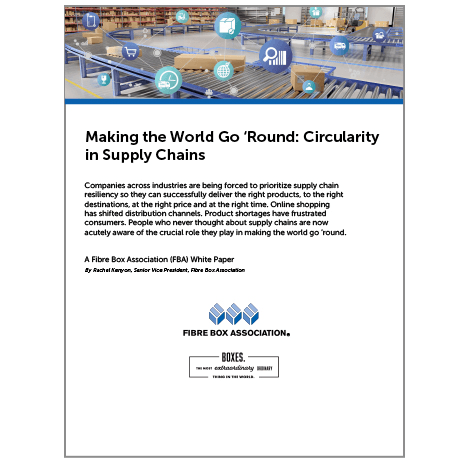
Corrugated Cardboard Packaging
Supply-Chain
Making the World Go ‘Round
Supply Chain Resiliency with Corrugated Cardboard Boxes
Never have the complexities and the crucial role of supply chains been so clear to the public as they were with pandemic-related disruptions affecting everyday life. Issues related to supply and demand of certain products have highlighted the need for greater visibility into inventories and movement through distribution. But that is not the only issue on people’s minds.
We have seen an extraordinary acceleration of major shifts in the way people want to shop, and even what they want to buy:
- People have learned to expect options like contactless transactions, home delivery, online shopping, click-and-collect, and other new ways to get what they need.
- Retailers, restaurants and suppliers have had to figure out how to meet customers where they are, even as the ground shifts beneath their feet.
- Public interest in sustainability has increased, along with a growing focus on healthy lifestyles and social responsibility. It all adds up to a day of reckoning for companies across industries.
Companies across industries are being forced to prioritize supply chain resiliency so they can successfully deliver the right products, to the right destinations, at the right price and at the right time. Online shopping has shifted distribution channels. Product shortages have frustrated consumers. People who never thought about supply chains are now acutely aware of the crucial role they play in making the world go ‘round.
Corrugated cardboard boxes have been recognized as the backbone of the American supply chain. The fast-tracked shift to e-commerce has kept the industry on its toes, working with brand owners and consumer packaged goods (CPG) customers to adjust box sizes, enhance the consumer’s in-home experience with high-quality graphics, and communicate brand values.
Leverage corrugated cardboard's versatility to adapt and delight
Growth in e-commerce means more products are shipped in smaller units, to far more end destinations. Protecting those products along the way, throughout the supply chain, is different than bulk delivery to retailers.
That means the packaging is different. Instead of shipping a pallet of products to a store, sellers are shipping single units to many more destinations. Those packages end up in people’s homes, instead of in stores. There, the consumer’s experience will shape their perception of the brand.
Direct delivery to consumers opens a golden opportunity for brands to shine. The product must first arrive in perfect condition – adequately protected through shipping and delivery, looking good, in a container that has withstood its journey to their homes.
To really score points, the package can become a branding vehicle used to delight shoppers. Corrugated printing technologies have advanced in the past few years to make high-quality graphics better than ever – so the box can be used to deliver a powerful brand message. It’s an opportunity to brighten someone’s day by showing up looking beautiful and speaking directly to them.
The package can also be used to communicate brand values, in addition to merchandising. Do not underestimate consumers’ sensitivity to issues around sustainability. They do not want to receive items over-packaged, so right-sizing the box is important. The fewer packing materials needed to fully protect the product inside the box, the better. The less waste generated in a consumer’s household, the more positively they will feel about the package and the brand.
Brands that successfully adapt to continue selling and delivering positive experiences, through whatever channels consumers prefer, have an opportunity to pull ahead and gain loyal customers for the long haul.
Get on board
CPG companies and retailers can do their part by providing products in recyclable corrugated boxes, and by purchasing boxes that are right-sized for optimal material use. Equally important, make sure that the boxes are marked with the Corrugated Recycles emblem and go the extra mile to encourage consumers to place the empty boxes into their recycling bins.
